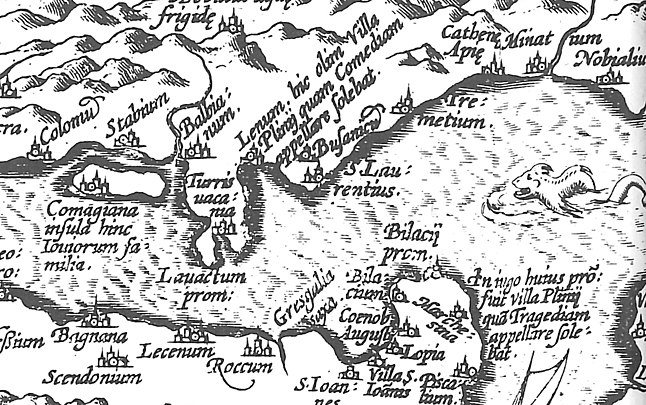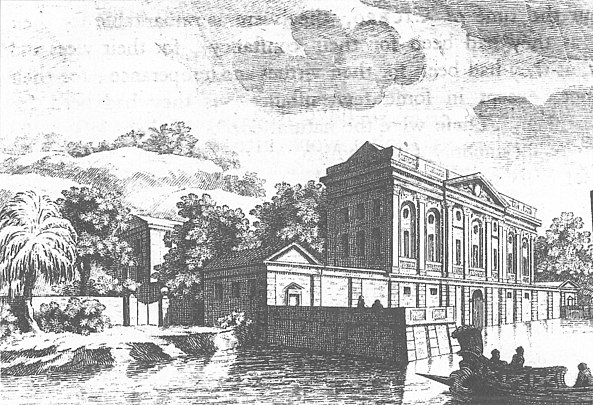Villas of Pliny the Younger on Lake Como
The Roman politician, senator and writer Pliny the Younger owned several villas on Lake Como in northern Italy, which are known for being mentioned in his surviving correspondence .
Description in the "villa letter" 9.7
In a letter to his friend Voconius Romanus, Pliny the Younger writes that of his various villas on Lake Como, he particularly prefers two. One is located (according to Pliny in the manner of the villas in Baiae ) on a hill that is set back from the lake between two bays, the other is near a small bay (according to Pliny also as usual in Baiae) with its terrace the water. Because of this topographical location, he calls the first-mentioned country residence “tragedy”, while the second is called “comedy”. This is an ironic allusion to the footwear that was typical for the actors of the respective genres: tragedy actors usually wore the so-called Kothurn , which, with their extremely high soles, almost resembled stilts; the actors in comedies , on the other hand, appeared in flat sandals.
The associated description of the country seats, like Pliny 's entire corpus of letters, serves literary purposes and is designed accordingly. For example, research highlighted that both villas have female names and the letter mainly describes the way in which they present themselves to the (male) viewer. The comedy villa is characterized by elegant curves (“molli curvamine” and “leviter inflectitur”), while the tragedy villa is characterized by a steep rock ridge and a straight promenade. With this, Pliny alludes, among other things, to the story of Heracles at the crossroads , in which the external and internal virtues of two women are also portrayed with allegorical significance. In addition, who Amores of Ovid inspired the letter 9.7. There is talk of the female personifications of the genres elegy and tragedy, which present themselves in their opposing forms, whereby the tragedy is also characterized here by the Kothurn. Both in the Herakles saga and in Ovid, the external differences between women are also associated with contradicting internal characteristics, and this, too, Pliny imitates with regard to the villas. Their advantages are contrasted antithetically by alternately listing the different views, the respective location in the landscape, the outdoor facilities and the different proximity to the water. This form of juxtaposition is typical of the Pliny letters. In the case of the villas, however, the author anticipates that both properties are of equal importance to him, precisely because of their contradictions. In doing so, he evades the decision that Heracles and Ovid had to make in the relevant situations.
When choosing and maintaining his villas, Pliny was therefore not concerned with different lifestyles or occupations, but with complementary forms of enjoyment. His villa letters reflect a need of the city dweller to observe nature and landscape, which should not be confused with the will to actually come into contact with nature. He writes, by the tragedy villa could be the fishermen work to watch , while the comedy Villa lies so close to the water that you can fish almost from the bed itself from the bedroom, even could . Actually fishing, on the other hand, is of no importance to Pliny. Even if he suggests these functional aspects of his villas on Lake Como, he ultimately focuses on their aesthetic value.
Pliny 's estate on Lake Como
Pliny came from the wealthy upper class of Comum (today's Como ) and was a so-called homo novus , i.e. the first member of his family to rise to the Senate. Nevertheless, he remained closely connected to his homeland throughout his life, as can be seen from numerous passages in his letters. He also appeared there several times as a founder and benefactor ( Euerget ). With regard to the comedy and tragedy mansions, Pliny writes that he intends to expand both of them, that is, to maintain and increase their value and attractiveness.
As can be seen from the corresponding letter, the two villas described in more detail were not his only ones on Lake Como. However, nothing is known in detail about the position and shape of the remaining buildings and properties. That Pliny owned at least three mansions in a single town is extraordinary and suggests that he owned an extraordinarily large amount of land there. He must have inherited at least part of this: In a letter to his grandfather-in-law Fabatus, he emphasizes that he is very attached to his parents' inheritance on Lake Como, as he has a special connection to them - his other properties there, however, are for sale ready. For example, he inherited five twelfth of the land in the Comum area from an unnamed other person. This share is said to have been worth 900,000 sesterces , but was then sold to an acquaintance named Corellia for a friendship price of 700,000 sesterces. In view of these sums, all of Pliny’s possessions around Comum were certainly worth several million sesterces. Eugène Allain suspected that Pliny inherited about a third of his possessions on Lake Como from his mother and two thirds from his friends. However, this estimate was challenged by Vito Antonio Sirago.
Location and reconstruction of the villas
Both the Comedy Villa and the Tragedy Villa have been destroyed and can no longer be clearly identified. It is believed that the latter stood in what is now Bellagio . On the other hand, there are various speculations about the location of the former. However, in 1876 a Roman mosaic floor and Roman coins were discovered in Lierna on Lake Como. It was therefore assumed that these findings were the remains of the comedy mansion. Other researchers, including Paolo Giovio (1483–1552), assume a localization in the Bay of Lenno , among other things because of the formulations in the Pliny letters .
The information given by Pliny is insufficient to reconstruct the villas. Therefore, corresponding attempts were hardly made, in contrast to the Pliny villas in Laurentum and Tuscany , which the writer describes in much more detail. However, the English artist Samuel Wale created an imaginative reconstruction of the comedy villa, which illustrated an English translation of the Pliny letters by John Boyle, 5th Earl of Cork , published in 1751 .
Detail from the map of Lake Como in the Theatrum Orbis Terrarum . The editor locates the Pliny villas opposite in Bellagio and Lenno. The tragedy villa is marked with “In iugo huius pro (munturii) fuit villa Plinii qua Tragediam appellare solebat”, the comedy villa with “hic olim villa Plinii quam Comediam appellare solebat”
Reconstruction of the Comedy Villa by the English artist Samuel Wale
literature
- Vito Antonio Sirago: L'Italia agraria sotto Traiano (= Recueil de travaux d'histoire et de philologie. Series 4, fascicle 16). Université de Louvain, Louvain 1958, p. 26 f.
- Roy K. Gibson, Ruth Morello: Reading the Letters of Pliny the Younger: An Introduction. Cambridge University Press, Cambridge 2012, ISBN 978-0-521-84292-1 , pp. 200 f. and pp. 203-211.
Individual evidence
- ↑ On this see Anthony R. Birley : Onomasticon to the Younger Pliny. Letters and Panegyric. KG Saur, Munich / Leipzig 2000, ISBN 3-598-73001-2 , p. 101.
- ↑ Pliny the Younger , Letters 9: 7. Comment on this letter is provided by AN Sherwin-White : The Letters of Pliny. A historical and social commentary. Corrected new edition, Clarendon Press, Oxford 1985, ISBN 0-19-814435-0 , p. 486.
- ↑ Ovid, Elegies 3.1. On the literary models Roy K. Gibson, Ruth Morello: Reading the Letters of Pliny the Younger: An Introduction. Cambridge University Press, Cambridge 2012, ISBN 978-0-521-84292-1 , pp. 207-209.
- ^ Roy K. Gibson, Ruth Morello: Reading the Letters of Pliny the Younger: An Introduction. Cambridge University Press, Cambridge 2012, ISBN 978-0-521-84292-1 , pp. 204-207.
- ^ Roy K. Gibson, Ruth Morello: Reading the Letters of Pliny the Younger: An Introduction. Cambridge University Press, Cambridge 2012, ISBN 978-0-521-84292-1 , p. 209.
- ↑ Eckard Lefèvre: Pliny studies I: Roman building convictions and conception of landscape in the villa letters (2.17; 5.6). In: Gymnasium . Volume 84, 1977, pp. 519-541, here p. 523 ( online ).
- ↑ Helmut Krasser : Pliny 2. In: Der Neue Pauly (DNP). Volume 9, Metzler, Stuttgart 2000, ISBN 3-476-01479-7 , Sp. 1141-1144.
- ↑ Sven Page: The ideal aristocrat. Pliny the Younger and the Social Profile of the Senators in the Imperial Era. Verlag Antike, Heidelberg 2015, ISBN 978-3-938032-95-4 , pp. 190–210 and pp. 319–341.
- ↑ Pliny the Younger, Letters 9,7,4. Sven Page: The ideal aristocrat. Pliny the Younger and the Social Profile of the Senators in the Imperial Era. Verlag Antike, Heidelberg 2015, ISBN 978-3-938032-95-4 , p. 321.
- ↑ TO Sherwin-White : The Letters of Pliny. A historical and social commentary. Corrected new edition, Clarendon Press, Oxford 1985, ISBN 0-19-814435-0 , p. 486.
- ↑ Pliny the Younger, Letters 7:11. See also Pierre de la Ruffinière du Prey: The Villas of Pliny from Antiquity to Posterity. University of Chicago Press, Chicago 1994, ISBN 0-226-17300-3 , pp. 3 and 13.
- ↑ Sven Page: The ideal aristocrat. Pliny the Younger and the Social Profile of the Senators in the Imperial Era. Verlag Antike, Heidelberg 2015, ISBN 978-3-938032-95-4 , p. 322.
- ^ Eugène Allain: Pline le Jeune et ses héritiers. 3 volumes, Albert Fontemoing, Paris 1901–1902, Volume 1, p. 67 ( digitized version ).
- ↑ Vito Antonio Sirago: L'Italia agraria sotto Trajan. Université de Louvain, Louvain 1958, p. 26 f.
- ↑ Pierre de la Ruffinière du Prey: The Villas of Pliny from Antiquity to Posterity. University of Chicago Press, Chicago 1994, ISBN 0-226-17300-3 , p. 5.
- ↑ Vito Antonio Sirago: L'Italia agraria sotto Trajan. Université de Louvain, Louvain 1958, p. 26.
- ^ Aurelio Goretti: Lierna: un paese tra lago e monti. 2001, accessed February 19, 2019 (Italian).
- ↑ Vito Antonio Sirago: L'Italia agraria sotto Trajan. Université de Louvain, Louvain 1958, p. 26 f.
- ↑ Pierre de la Ruffinière du Prey: The Villas of Pliny from Antiquity to Posterity. University of Chicago Press, Chicago 1994, ISBN 0-226-17300-3 , especially pp. 5-8.

